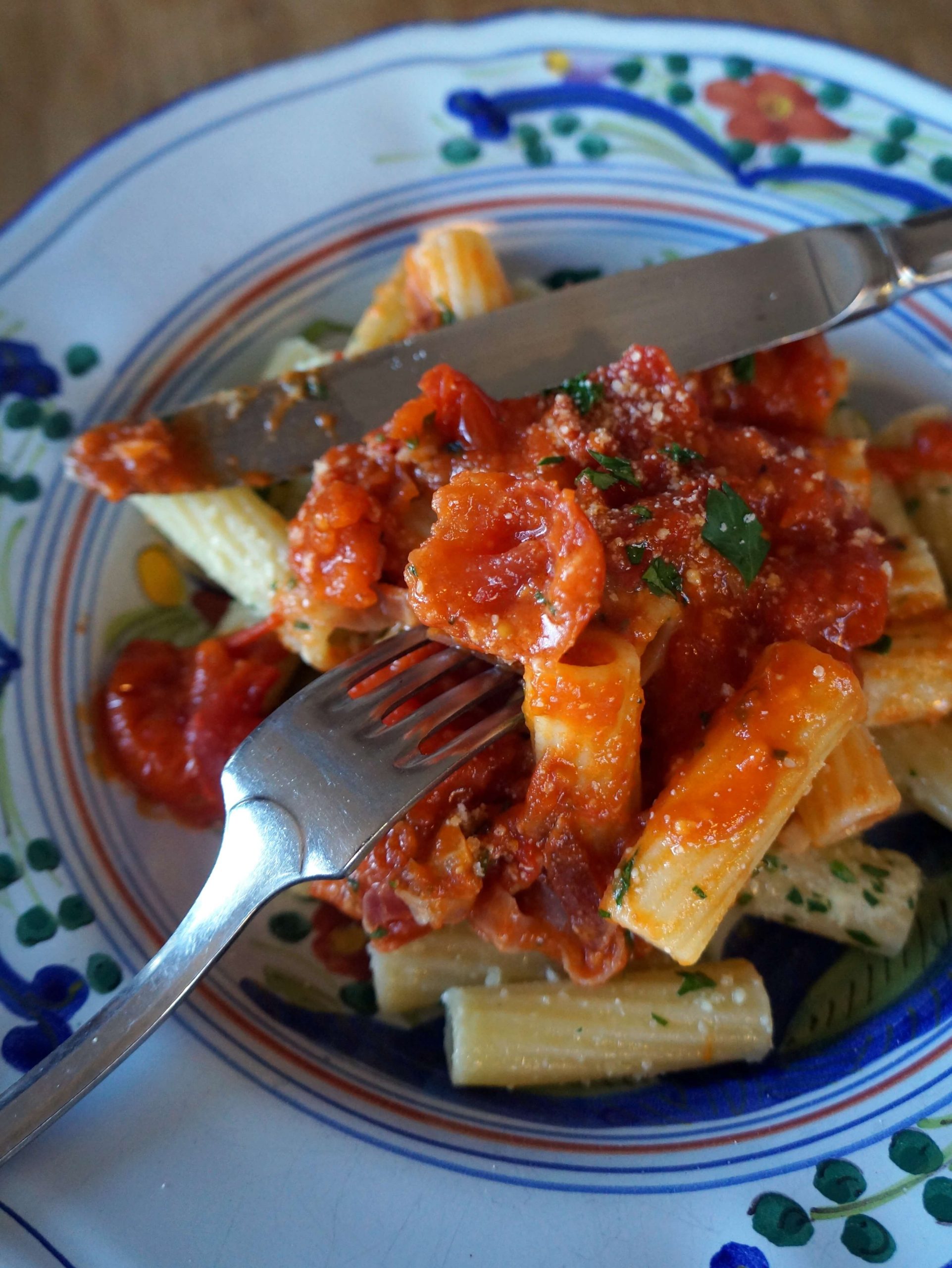Ever eaten a bowl of spaghetti or a slice of basic pizza with the kind of tomato sauce that makes the pasta or dough sing? One in which the flavor of the tomatoes is pronounced. You get that naturally sweet taste with a lingering savoriness? That’s the kind of tomato sauce I dream of, one that few home cooks, chef or restaurateurs master.
The secret to such sauces is a quality tomato, minimally processed. In summer you might find one locally-grown. But in winter, we rely on canned tomatoes. I always look for authentic San Marzano canned tomatoes grown in Italy. (Gustiamo in Brooklyn carries several brands of Italian grown and packed tomatoes as does Fromage in Old Saybrook, Connecticut not to mention other shops locally.)
For this Penne Rigate Salsa di Pomodorini recipe I used pomodorini, canned cherry tomatoes. Because they are canned in juice, these pomodorini have an exceptionally fresh taste. You can see these whole intact cherry tomatoes in the can and bobbing in the sauce.
Because fast and fresh in my 2020 mantra, I wanted to prepare a meal that anyone can make in a short amount of time. You boil the pasta while the tomatoes simmer. I chose penne rigate for this recipe. When cooked properly al dente and chewy, the penne acquire a heft and “meatiness” that makes for a satisfying meal. We don’t serve pasta often so when we do, we use the best ingredients we can find.
A nob of butter and a fat hot pepper round out the flavors in the sauce. Add shreds of prosciutto after the pasta cooks to enhance the umami flavors.
Kitchen Notebook
In recent years, the quality of canned tomatoes in the US has declined. Many contain sugar, corn syrup, salt and other additives. Some US canned tomatoes say “San Marzano” or “San Marzano-style” tomatoes on their labels. This is a reference to the plum variety prized for sauce making. Genuine Pomodoro San Marzano dell’Agro Sarnese-Nocerino DOP, when labeled PDO (Protected Denomination of Origin) or DOP (Denominazione d’Origine Protetta), are grown in the volcanic soils around Naples. Italian labeling identifies both the variety and the growing region in recognition of all the characteristics that goes into a quality food.
One of China’s largest exports is tomatoes, accounting for about 30% global output. These industrial ingredients make their way into ketchup and jarred tomato sauce. And perhaps too into some of the product on local store shelves.
Greatest Tomatoes from Europe is a campaign to introduce more people to Italian-grown canned tomatoes. I support their efforts. They sent me these tomatoes to test along with one of the brands of dry pasta from Gragnano, Italy I like the best, Di Martino.

For this dish, canned Italian grown cherry tomatoes make a flavorful sauce served over penne rigate pasta. Plate the finished dish in two layers. First each serving bowl is layered with some buttered penne rigate. Then the remaining penne rigate is tossed with some of the tomato sauce and slivers of prosciutto. After the sauced pasta is placed in each serving bowl, each portion is dressed with more sauce. Serving in this manner adds different layers of flavor to the bowl of chewy penne rigate.
Ingredients
2 Tablespoons olive oil
1 clove garlic, sliced
One 8 ounce (240 gram) can Italian pomodorini, canned cherry tomatoes in juice
1 dried cayenne or other chile hot pepper
Pinch salt
3 Tablespoons unsalted butter
Pinch dried oregano
8 ounces penne rigate
2 tablespoons chopped fresh flat leaf parsley
Grated Parmigiana cheese
3 - 4 slices of thin-cut prosciutto, cut into thin slivers, optional
Directions
- Heat the oil over medium heat in a shallow saucepan. Add the garlic and sauté for one minute until the garlic just becomes fragrant.
- Add the can of tomatoes, cayenne pepper, salt, 2 Tablespoons of the butter and oregano.
- Simmer covered, stirring and crushing the whole tomatoes from time to time for 10-15 minutes.
- While the sauce simmers, cook the pasta in rapidly boiling salted water until al dente, for approximately 10-11 minutes.
- Drain the pasta. Toss it in a bowl with the remaining butter and the parsley. Sprinkle with some grated Parmigiana.
- Divide half of the pasta between four heated serving bowls.
- Add half of the sauce and the prosciutto to the remaining pasta. Divide the sauced pasta between the four serving bowls. Top with more sauce.
- Sprinkle each serving with more grated cheese and hot pepper flakes.









